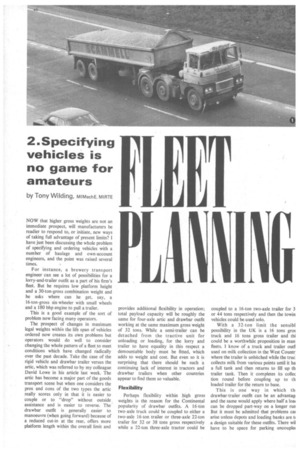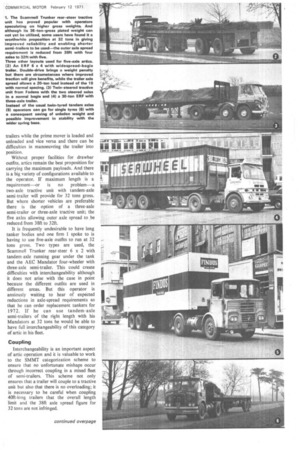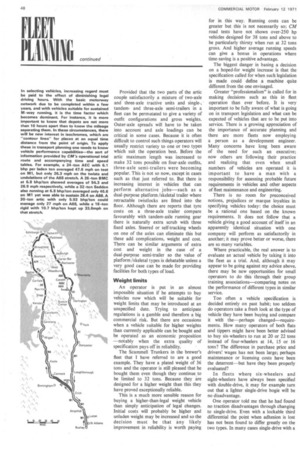2. Specifying FLEET vehicles is no game for amateurs
Page 48

Page 49

Page 50

Page 51

If you've noticed an error in this article please click here to report it so we can fix it.
by Tony Wilding, MIMechE,MIRTE
NOW that higher gross weights are not an immediate prospect, will manufacturers be readier to respond to, or initiate, new ways of taking full advantage of present limits? I have just been discussing the whole problem of specifying and ordering vehicles with a number of haulage and own-account engineers, and the point was raised several times.
For instance, a brewery transport engineer can see a lot of possibilities for a lorry-and-trailer outfit as a part of his firm's fleet. But he requires low platform height and a 30-ton-gross combination weight and he asks where can he get, say, a 16-ton-gross six-wheeler with small wheels and a 180 bhp engine to pull a trailer.
This is a good example of the sort of problem now facing many operators.
The prospect of changes in maximum legal weights within the life span of vehicles ordered now creates its own problems but operators would do well to consider changing the whole pattern of a fleet to meet conditions which have changed radically over the past decade. Take the case of the rigid vehicle and drawbar trailer versus the artic, which was referred to by my colleague David Lowe in his article last week. The artic has become a major part of the goods transport scene but when one considers the pros and cons of the two types the artic really scores only in that it is easier to couple or to "drop" without outside assistance and is easier to reverse. The drawbar outfit is generally easier to manoeuvre (when going forward) because of a reduced cut-in at the rear, offers more platform length within the overall limit and
provides additional flexibility in operation; total payload capacity will be roughly the same for four-axle artic and drawbar outfit working at the same maximum gross weight of 32 tons. While a semi-trailer can be detached from the tractive unit for unloading or loading, for the lorry and trailer to have equality in this respect a demountable body must be fitted, which adds to weight and cost. But even so it is surprising that there should be such a continuing lack of interest in tractors and drawbar trailers when other countries appear to find them so valuable.
Flexibility Perhaps flexibility within high gross weights is the reason for the Continental popularity of drawbar outfits. A 16-ton two-axle truck could be coupled to either a two-axle 16-ton trailer or three-axle 22-ton trailer for 32 or 38 tons gross respectively while a 22-ton three-axle tractor could be coupled to a 16-ton two-axle trailer for 3 or 44 tons respectively and then the towin vehicles could be-used solo.
With a 32-ton limit the sensibl possibility in the UK is a 16 tons gros truck and 16 tons gross trailer and thi could be a worthwhile proposition in man fleets. I know of a truck and trailer outf used on milk collection in the West Countr where the trailer is unhitched while the true, collects milk from various points until it ha a full tank and then returns to fill up th trailer tank. Then it completes its collec tion round before coupling up to th loaded trailer for the return to base.
This is one way in which th drawbar-trailer outfit can be an advantag and the same would apply where half a lotu can be dropped part-way on a longer run But it must be admitted that problems cal arise unless depots and loading banks are ti a design suitable for these outfits. There wil have to be space for parking uncouple4 trailers while the prime mover is loaded and unloaded and vice versa and there can be difficulties in manoeuvring the trailer into position.
Without proper facilities for drawbar outfits, attics remain the best proposition for carrying the maximum payloads. And there is a big variety of configurations available to the operator. If maximum length is a requirement—or is no problem—a two-axle tractive unit with tandem-axle semi-trailer will provide for 32 tons gross. But where shorter vehicles are preferable there is the option of a three-axle semi-trailer or three-axle tractive unit; the five axles allowing outer axle spread to he reduced from 38ft to 32ft.
It is frequently undesirable to have long tanker bodies and one firm I spoke to is having to use five-axle outfits to run at 32 tons gross. Two types are used, the Scammell Trunker rear-steer 6 x 2 with tandem-axle running gear under the tank and the AEC Mandator four-wheeler with three-axle semi-trailer. This could create difficulties with interchangeability although it does not arise with the case in point because the different outfits are used in different areas. But this operator is anxiously waiting to hear of expected reductions in axle-spread requirements so that he can order replacement tankers for 1972. If he can use tandem-axle semi-trailers of the right length with his Mandators at 32 tons he would be able to have full interchangeability of this category of artic in his fleet.
Coupling
Interchangeability is an important aspect of attic operation and it is valuable to work to the SMMT categorization scheme to ensure that no unfortunate mishaps occur through incorrect coupling in a mixed fleet of semi-trailers. This scheme not only ensures that a trailer will couple to a tractive unit but also that there is no overloading; it is• necessary to be careful when coupling 40ft-long trailers that the overall length limit and the 38ft axle spread figure for 32 tons are not infringed. Provided that the two parts of the artic couple satisfactorily a mixture of two-axle and three-axle tractive units and single-, ' tandemand three-axle semi-trailers in a fleet can be permutated to give a variety of outfit configurations and gross weights. Outer-axle spreads will have to be taken into account and axle loadings can be critical in some cases. Because it is often difficult to control such things operators will usually restrict variety to one or two types which suit the operation best. Before the artic maximum length was increased to make 32 tons possible on four-axle outfits, three-axle semi-trailers were becoming popular. This is not so now, except in cases such as that just referred to. But there is increasing interest in vehicles that can perform alternative jobs—such as a dual-purpose platform /skeletal trailer where retractable twistlocks are fitted into the floor. Although there are reports that tyre costs on a three-axle trailer compare favourably with tandem-axle running gear there is naturally extra scrub with three fixed axles. Steered or self-tracking wheels on one of the axles can eliminate this but these add complications, weight and cost. There can be similar arguments of extra cost and weight in the case of a dual-purpose semi-trailer so the value of platform /skeletal types is debatable unless a very good case can be made for providing facilities for both types of load.
Weight limits An operator is put in an almost impossible situation if he attempts to buy vehicles now which will be suitable for weight limits that may be introduced at an unspecified date. Trying to anticipate regulations is a gamble and therefore a big commercial risk. But there are occasions when a vehicle suitable for higher weights than currently applicable can be bought and be operated as an economic proposition —notably when the extra quality of specification pays off in reliability.
The Scammell Trunkers in the brewer's fleet that I have referred to are a good example. They have a plated weight of 36 tons and the operator is still pleased that he bought them even though they continue to be limited to 32 tons. Because they are designed for a higher weight than this they have proved exceptionally reliable.
This is a much more sensible reason for buying a higher-than-legal weight vehicle than simply anticipation of legal changes. Initial costs will probably be higher and unladen weight may be increased and so the decision must be that any likely improvement in reliability is worth paying
for in this way. Running costs can be greater but this is not necessarily so; CM road tests have not shown over-250 hp vehicles designed for 38 tons and above to be particularly thirsty when run at 32 tons gross. And higher average running speeds can give a bonus in operations where time-saving is a positive advantage.
The biggest danger in basing a decision on a hoped-for weight increase is that the specification called for when such legislation is made could define a machine quite different from the one envisaged.
Greater "professionalism" is called for in making decisions such as this in fleet operation than ever before. It is very important to be fully aware of what is going on in transport legislation and what can be expected of vehicles that are to be put into service. There is a growing appreciation of the importance of accurate planning and there are more fleets now employing a person as a development engineer. Many concerns have long been aware of the need for such an executive; now others are following their practice and realizing that even when small numbers of vehicles are operated it is important to have a man with a responsibility for assessing probable future requirements in vehicles and other aspects of fleet maintenance and engineering.
There is no room for preconceived notions, prejudices or marque loyalties in specifying vehicles today: the choice must be a rational one based on the known requirements. It does not follow that a vehicle giving a good account of itself in an apparently identical situation with one company will perform as satisfactorily in another; it may prove better or worse, there are so many variables.
Where practicable, the real answer is to evaluate an actual vehicle by taking it into the fleet as a trial. And, although it may appear to be going against my advice above, there may be new opportunities for small operators to do this through their group training associations—comparing notes on the performance of different types in similar service.
Too often a vehicle specification is decided entirely on past habit; too seldom do operators take a fresh look at the type of vehicle they have been buying and compare it with the—perhaps changed—requirements. How many operators of both flats and tippers might have been better advised to buy six-wheelers to run at 20 or 22 tons instead of four-wheelers at 14, 15 or 16 tons? The difference in purchase price and drivers' wages has not been large; perhaps maintenance or licensing costs have been the deterrent—but have they been properly evaluated?
In fleets where six-wheelers and eight-wheelers have always been specified with double-drive, it may for example turn out that a lighter single-drive bogie will be no disadvantage.
One operator told me that he had found no traction disadvantages through changing to single-drive. Even with a lockable third differential the point when adhesion is lost has not been found to differ greatly on the two types. In many cases single-drive with a lockable third differential---especially with a load-transfer device to add weight to the driving-axle--can rival double-drive.
Very often the operating side of the transport industry has to give a lead to manufactucers in the fitting of features which can play a part in keeping costs down. Examples which come to mind are the use of equipment that gives improved control over engine coolant temperatures such as the Dynair thermostatic fan drive and Kysor radiator shutter. In both cases stress is laid by the makers on fuel savings. but to my mind the greater benefit is in extended engine life, partly through reducing the temperature difference between inlet and outlet points of the coolant in the engine. Tests that I made with the Dynair equipment showed a remarkable improvement in coolant-temperature characteristics but like the Kysor shutter this equipment has to he specified by the operator or even fitted independently after the vehicle has been supplied.
In the face of continuously rising costs everything has to be done to improve efficiency. Quicker turn-round and the elimination of down-time are features that can be obtained if enough attention is paid to initial specifications of vehicles and bodies.
Maintenance And improved maintenance techniques can also help considerably in increasing efficiency. Maintenance is important not only in ensuring compliance with the current strict legal requirements. Long-held policies often need revising to make them suitable for the present-day situation. It used to be common to run a vehicle to something like 250,000 miles and then put it in workshops for a complete overhaul before it ran for perhaps only two or three years more in the fleet. One own-account operator told me that this is now completely out as far as he is concerned. Revised maintenance programmes are linked closely to annual tests, vehicle life has been reduced to seven years in the case of heavy vehicles and five in the case of medium weights, and the need for complete overhauls is avoided.
More intensive use of vehicles and the existence of motorways does not mean that mileages are necessarily any less. It is more common now that haulage vehicles regularly cover up to 100,000 miles in a year in the case of heavies and between 50,000 and 60,000 miles in a year in the case of medium weights. One haulier to whom I spoke keeps these classes of vehicles four years and three years respectively before replacement and finds that this gives the advantage of obtaining a good allowance on the used trucks.
Many vehicle workshops are outdated for present-day conditions and more cannot be expected to be much use when future requirements are taken into account. Many operators are having to consider rebuilding maintenance workshops with sophisticated diagnostic equipment, vehicle dynamometers and brake testers and so on. Rebuilding and re-equipping workshops is necessary not only so that the job can be done more efficiently but also so that personnel can be attracted to work on this side of the industry.
Too often the engineering part of a fleet has been considered the poor relation; a necessary evil whose costs have often tended to be considered as having an adverse effect on the earnings made by the vehicles. Legislation has forced a more enlightened view in respect of the maintenance function. Now, the part that engineering can play in improving profitability in many other ways is becoming more appreciated.
Next week a look at value engineering.
































































































